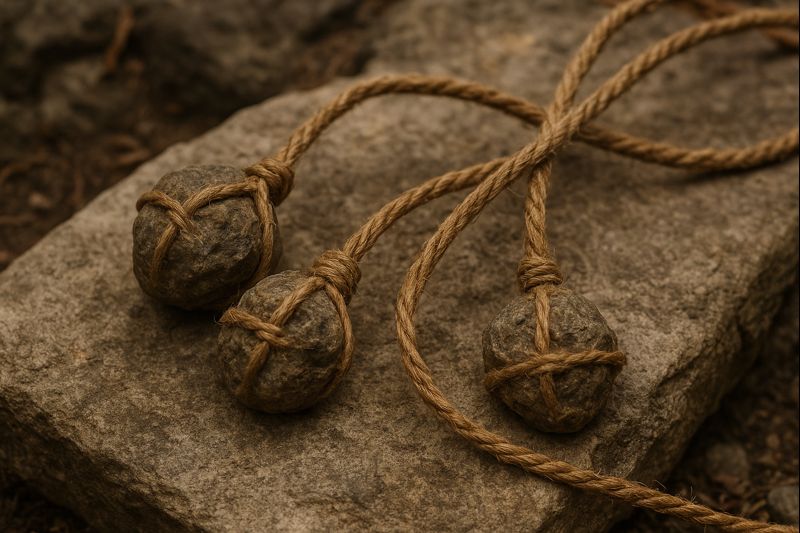When you’re deep in the wilderness and far from civilization, a few simple tools can make the difference between staying safe and becoming another bad story. These aren’t Hollywood weapons — they’re primitive survival tools humans have relied on for thousands of years to hunt small game, create distance from danger, and solve problems when modern gear fails.
This page may contain affiliate links; you can read our full disclosure.
Use these responsibly, legally, and only in legitimate survival situations.
1. A Simple Wooden Spear
A spear is one of the easiest and most reliable survival tools you can make with almost no materials. It gives you reach, control, and distance — three things that matter when things go sideways.
What you need:
- A long, straight branch (6 feet or longer)
- A knife or sharp stone
How to make it: Shave one end of the branch into a gradual point. Avoid making it needle-sharp — strength matters more than sharpness. Once shaped, harden the tip by slowly rotating it near hot coals. Do not place it directly in flames, which weakens the wood.
What it’s useful for:
- Keeping distance from aggressive animals
- Spear fishing where legal
- Small-game hunting in true survival situations
Why it works: It’s simple, durable, and provides reach when you need space between you and a problem.
2. A Bowed-Branch Club (Improvised Baton)
This tool is essentially a reinforced walking stick that can double as a defensive or utility tool.
What you need:
- A thick green branch
- A knife
How to make it: Trim off smaller branches and knots. Round sharp edges and carve a shallow grip near one end. Green wood is preferred because it flexes instead of snapping.
What it’s useful for:
- Making noise to scare off wildlife
- Clearing brush and obstacles
- Emergency self-defense if escape isn’t possible
Why it works: Humans have relied on simple impact tools forever. This is just a refined version of the oldest one.
3. Bolas (Cord-and-Weight Tool)
Bolas are a primitive hunting and restraint tool traditionally used to entangle the legs of animals rather than injure them. They rely more on timing and placement than raw force.
What you need:
- Two or three small, heavy stones
- Strong cordage, vine, or braided bark
How to make it: Tie each stone securely to the end of a cord. If using three weights, tie them evenly to a central knot. The cords should be long enough to wrap around limbs but short enough to stay controllable. Test the strength of each knot before relying on it.
How it’s used: Bolas are thrown in a spinning motion so the cords spread outward before wrapping around legs or wings. Accuracy and timing matter far more than strength.
What it’s useful for:
- Hunting small game in true survival situations
- Temporarily entangling animals to create distance
- Non-lethal restraint when avoidance isn’t possible
Why it works: Entanglement limits movement without requiring a sharp edge or close contact.
4. A Stone-Headed Hammer (Primitive Mallet)
This tool acts as a survival multitool — useful for building, processing materials, and heavy work that doesn’t require a blade.
What you need:
- A solid, rounded stone
- A forked branch or sturdy handle
- Rope, vine, or stripped bark for lashing
How to make it: Seat the stone firmly into the forked branch. Lash it tightly using cordage, wrapping in multiple directions until there is zero movement. The tighter the binding, the safer the tool.
What it’s useful for:
- Driving stakes
- Breaking wood and hard materials
- Crushing nuts or bone for marrow
Why it works: Simple leverage plus mass equals effectiveness.
5. A Survival Bow (Advanced Skill)
This tool requires time, skill, and patience. It should only be attempted if you understand basic bow mechanics and wood tension.
What you need:
- A flexible hardwood branch
- Strong cordage (paracord, vine, or inner bark)
How to make it: Shape the branch so both limbs thin evenly from the grip outward. The limbs should bend smoothly without cracking. String carefully — uneven tension is the most common failure point.
What it’s useful for:
- Long-term survival hunting
- Silent operation
- Reducing close-range animal encounters
Why it works: Bows have sustained human survival for tens of thousands of years.
Important Safety and Legal Notes
- These are survival tools, not everyday weapons
- Always check local laws before making or using improvised tools
- Never use these against people unless your life is in immediate danger
- Most wildlife encounters are best handled with distance and avoidance
- If you’re not in a survival situation, leave nature intact
Final Thoughts
Primitive survival tools exist for one reason: keeping you alive when modern gear fails. You don’t need to be a bushcraft expert — you need to understand how to turn raw materials into functional solutions.
Survival is about problem-solving, not fighting.

